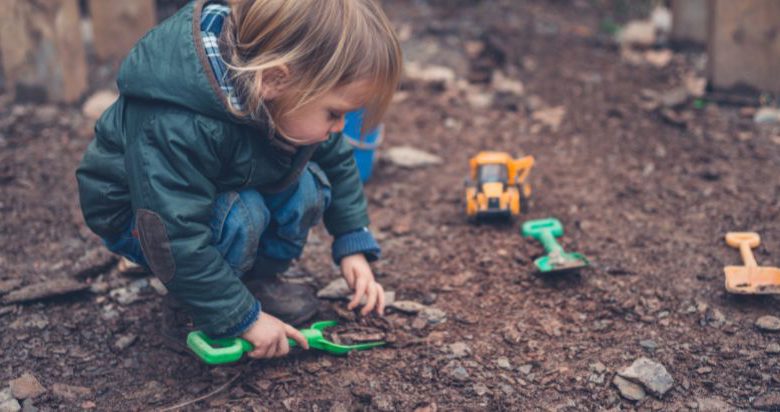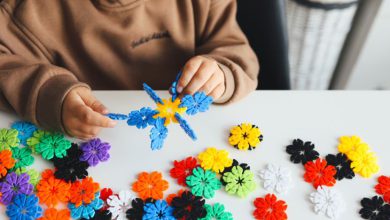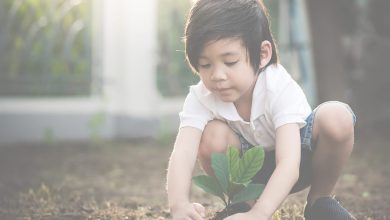Outdoor Sensory Play for Preschoolers: Engaging the Senses for Learning and Fun

Outdoor Sensory Play for Preschoolers: Engaging the Senses for Learning and Fun
With fall here and the temperatures allowing for grand outdoor adventures, we are ready for the captivating realm of outdoor sensory play for preschoolers! Don’t you just love the sheer delight of your little ones immersing themselves in a world of sensory exploration with laughter echoing through the air? This season is an endless opportunity for both learning and pure fun!
At this stage of early childhood, the development of the five senses is a pivotal milestone. Sight, hearing, taste, smell, and touch all play a vital role in shaping a child’s understanding of the world. That’s why we believe that outdoor play, with its abundance of sensory stimuli, can enhance their growth and learning experiences. In this post, we will dig into some fun activities that engage all of the senses while incorporating learning into outdoor playtime.
The Five Senses and Their Development in Preschoolers
Preschoolers’ are at such a fun age to watch and explore their surroundings. Everything still has that sense of newness and excitement that makes every day an exciting adventure while they begin to understand their senses and get a feel for how they impact their days. Here is a little insight into the five senses and how they develop in preschoolers.
Sight
Through their eyes, preschoolers observe vibrant colors, fascinating shapes, and captivating movements in their surroundings. Visual stimulation plays a key role in their cognitive and perceptual development, which is why most animated films and TV shows are so bright and lively. By taking the screens away and getting the kiddos outside, they can be stimulated by a whole world of colors and brightness that they will learn to interact with.
Hearing
The world is filled with a symphony of sounds just waiting to be discovered. From the chirping of birds to the rustling of leaves, preschoolers’ growing auditory abilities allow them to detect and distinguish various sounds, fostering their language development and auditory processing skills.
Taste
Oh, the delightful world of flavors! This may come as surprising, but preschoolers’ taste buds are constantly seeking new culinary experiences. Experiencing different tastes not only introduces them to diverse foods but also stimulates their sense of taste, helping them develop preferences and an awareness of different flavors, which can greatly assist with picky eating and perhaps help to avoid it altogether.
Smell
The air carries a bouquet of scents, each with its own story to tell. Preschoolers’ olfactory senses are finely attuned to the world around them. Whether it’s the aroma of freshly baked cookies or the fragrance of blooming flowers, their sense of smell aids in memory formation and emotional connections.
Touch
Our skin is a gateway to discovery, and preschoolers are eager pioneers. Their sense of touch allows them to feel various textures, temperatures, and sensations, enabling them to understand their environment better and refine their fine motor skills. They may also find some sensations especially comforting such as a specific toy or blanket they favor.
Importance of Sensory Development During The Preschool Years
Engaging the senses through purposeful play and exploration lays the foundation for various cognitive, social, and physical skills. These years are critical in sensory development, where you will start to see changes in a few key areas.
Cognitive Development: You will start to see your child developing cognitive skills such as problem-solving, critical thinking and spatial awareness. Sensory experiences really help this process by providing valuable input to a child’s brain, helping them make connections, form memories, and develop cognitive skills.
Language Development: Sensory-rich experiences stimulate language development as children encounter new sights, sounds, tastes, smells, and textures. Describing and discussing sensory experiences build their vocabulary and ability to express themselves. After taking a nature walk or just exploring the back yard, ask questions about what they’ve seen and heard to work on expanding that knowledge!
Emotional and Social Development: Sensory play can evoke a range of emotions and contribute to the development of emotional intelligence. It also offers opportunities for social interaction, cooperation, and empathy as children engage in shared sensory experiences.
Physical Development: Sensory play encourages the refinement of fine and gross motor skills. Whether it’s manipulating objects, navigating uneven terrain, or engaging in physical activities, the senses play a crucial role in developing coordination, balance, and body awareness. It can be so fun to help your child walk across a fallen log and see the look of achievement on their face when they’ve made it across!
By understanding the significance of sensory development during the preschool years, we can embrace outdoor sensory play as a powerful tool for supporting our little ones’ growth and providing them with a solid foundation for future learning adventures.
“ Restore balance. Most children have technology, school, and extracurricular activities covered. It’s time to add a pinch of adventure, a sprinkle of sunshine, and a big handful of outdoor play.” -Penny Whitehouse
Ideas for Outdoor Sensory Play Activities
Nature Scavenger Hunts
Create a checklist of natural objects like flowers, leaves, or rocks for preschoolers to find. Encourage them to use their sense of sight to locate and identify each item.
Exploring Colors and Shapes
Take a walk outdoors and point out different colors and shapes in the environment. Engage preschoolers in conversations about what they see, fostering their visual perception and vocabulary.
Listening Walks or Sound Hunts
Encourage children to focus on the sounds around them during a nature walk. Help them to identify and mimic bird songs, rustling leaves, or other interesting sounds they encounter.
Outdoor Musical Instruments
Set up an outdoor music station with items like drums, chimes, or shakers. Allow children to experiment and create their own melodies, building auditory discrimination and rhythmic abilities.
Planting and Harvesting
Create a small garden where preschoolers can plant and care for fruits, vegetables, or herbs. Involve them in the process from seed to harvest, allowing them to explore different tastes and textures.
Picnics with a Twist
Organize outdoor picnics with a variety of healthy snacks, including fruits, veggies, and dips. Encourage children to try different flavors, discuss their preferences and expand their palate.
Nature’s Aromas
Take preschoolers on a sensory journey through the world of scents. Encourage them to smell flowers, herbs, or other aromatic plants, discussing the different smells they encounter.
Sensory Bins
Create sensory bins with scented materials like dried lavender, cinnamon sticks, or citrus peels. Allow children to explore and identify different scents using their sense of smell.
Sensory Nature Walks
Take preschoolers on nature walks where they can touch and feel various textures like tree bark, soft moss, or rough rocks. Lead descriptive discussions about the different sensations they experience.
Sensory Play with Sand, Water, and Mud
Set up outdoor stations with sand, water, and mud for children to engage in tactile experiences. Provide tools and objects for them to manipulate, building their fine motor skills.
By incorporating these outdoor sensory play activities into our preschoolers’ routines, we provide them with rich opportunities to engage their senses, explore their environment, and grow a deeper understanding of the world around them. So, venture outdoors and let their senses guide them on amazing learning and fun-filled adventures!
Incorporating Learning into Outdoor Sensory Play
With the addition of learning elements in outdoor sensory play, we can create an environment that seamlessly merges education and fun. These activities not only engage the senses but also promote cognitive development, language skills, and imaginative thinking, ensuring that our preschoolers receive a holistic and enriching learning experience. Try tacking on these bonus activities to your planned outdoor adventures for an added educational spin.
Counting or Sorting Natural Objects during Scavenger Hunts
As preschoolers engage in nature scavenger hunts, encourage them to count or sort the items they find. This simple addition enhances their numeracy skills and promotes cognitive development.
Naming and Categorizing Different Sounds or Smells
During outdoor sound hunts or scent exploration activities, prompt children to name and categorize the various sounds or smells they encounter. This language-rich experience strengthens their vocabulary and cognitive abilities.
Describing and Discussing Different Textures and Temperatures
When preschoolers engage in sensory nature walks or tactile experiences, have them describe the textures they feel and discuss the varying temperatures. This promotes their ability to articulate observations and develop language skills.
Encouraging Imaginative Play with Sensory Materials
Provide opportunities for open-ended play with sensory materials such as sand, water, or natural loose parts. Lead preschoolers in using their imagination and creativity to manipulate and transform the materials, fostering cognitive and social-emotional development.
Safety Considerations for Outdoor Sensory Play
By prioritizing safety during outdoor sensory play, we can create an environment that promotes well-being and minimizes potential risks. With proper supervision, sun protection, and awareness of potential allergens or hazards, we can ensure that our preschoolers have a safe and enjoyable sensory play experience.
Adult Supervision and Guidance: Ensure that outdoor sensory play activities are conducted under the supervision of responsible adults who can provide guidance, set boundaries, and ensure the safety of the children.
Sun Protection and Appropriate Clothing: Prioritize sun safety by ensuring children wear sunscreen, hats, and protective clothing during outdoor play. Consider the weather and dress appropriately to prevent overheating or exposure to extreme temperatures.
Potential Allergens and Hazards in the Environment: Take precautions to identify and mitigate potential allergens or hazards in the outdoor environment. Be mindful of any plants, insects, or substances that may cause allergic reactions or pose safety risks. Conduct a thorough inspection of the play area before engaging in sensory activities.
We hope you enjoy this list of outdoor activities with your child this summer and watch them thrive in their environment. You will most likely get to learn alongside them and experience just as much excitement!





